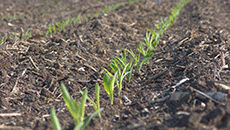
The optimum planting window for the summer crops of maize and soybeans has passed, with hardly anything planted in the Western parts of the production areas. There is still some time left to grow sunflowers. “The probability of a repeat of the 2016 drought is increasing daily” Jannie de Villiers, CEO of Grain SA said today. “Some of the scenarios we are facing, looks even grimmer than the previous drought. The financial position of most farming units in the production area are far worse than it was in 2016. The current grain prices are not high enough and thus do not favour nor encourage farmers to take a similar risk by planting beyond the optimum window, as they did in 2016.” de Villiers said.
The South African economy and consumers especially, can hardly afford yet another blow. In addition, adding high food inflation during an election year will likely just add fuel to an already smouldering fire. Grain and grain based products like chicken, eggs, red meat and dairy products represent 75% of the food basket. Should the current conditions continue, the likelihood of maize imports become a reality! This could result in white maize (WM) prices moving to import parity levels of well over R4 000 per ton form the current levels of approximately R3 000 per ton, with especially white maize that is of concern. Traditionally, white maize is predominantly grown in the western production areas where almost no planting has taken place. White maize is also not readily available for imports as it is mostly produced in the southern parts of Africa and around Mexico. The global stocks of yellow maize (YM) that goes for animal feed is however in plentiful supply. However, if it has to be imported, the prices will also increase substantially.
The grain farmers in the Free State and North West will need between 25mm and 50mm of rain to start planting, with immediate follow-up rain. Furthermore, the crops planted in the eastern parts of South Africa is also struggling. The conditions are far from ideal. “If we consider the current crop status planted, late plantings or even no plantings, the farmers and South Africa is in for a very rough ride in 2019.” de Villiers added. It is early days to try and estimate a crop for 2019, but the probability of a short crop is increasing by the day. Most farmers were in a position to survive the drought of 2016, but this time around the majority of farmers are not in any kind of position, to deal with or manage this current drought. A crop failure implies that the opportunity for grain farmers to generate an income is only in July 2020 when a next crop can be harvested. The payments for current inputs (seed, fertilizer, diesel and chemicals) as well as all fixed costs for the year ahead still needs to be settled.
Grain SA will engage with input suppliers, financial institutions and Government to try and find solutions. The drought effects all farmers irrespective of race or size. “We will need to work together to maintain our status as a food secure nation. Drought is not a political matter, but one of co-operation to ensure a nation can be fed for the long haul.” de Villiers concluded.
Ends
Issued by:
Grain SA Communication
Further Enquiries:
Jannie de Villiers , CEO, Grain SA
jannie@grainsa.co.za
Jaco Minnaar , Chairperson, Grain SA
083 626 7000